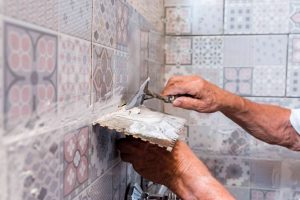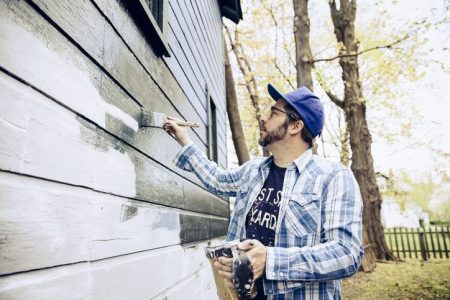Over the years, stucco can wear down, chip, or even crack, making the home more vulnerable to leaks, mold growth, and water damage. Calling in a pro to repair stucco comes with the added cost of labor, so DIYers with enough experience and some spare time can tackle a stucco repair project themselves. Just make sure to choose a day with relatively warm temperatures, between 40 to 90 degrees Fahrenheit for the best results.
Use this guide to learn how to make and how to repair stucco on your home.
How to Make Stucco
To make stucco, you will need Portland cement, mason’s sand, concrete aggregate sand, hydrated lime, and an acrylic bonding agent. For the first coat, also known as the scratch coat, add half a 47 pound bag of Portland cement, six shovelfuls of mason’s sand, and one shovelful of hydrated lime to a wheelbarrow, then blend the ingredients.
Next, add half a cup of acrylic bonding agent, then stir in water a little at a time until the mix has a buttercream frosting consistency.
For the second coat, also known as the brown coat, add add half of a 47 pound bag of Portland cement, eight shovelfuls of concrete aggregate sand, and one shovelful of hydrated lime to a wheelbarrow, then blend the ingredients.
Same as the first coat, add half a cup of acrylic bonding agent, then stir in water a little at a time to get the intended buttercream frosting consistency.
What You’ll Need
Equipment / Tools
- Hammer
- Cold chisel
- Wire or tin snips
- Masonry trowel
Materials
- Portland cement
- Mason’s sand
- Concrete aggregate sand
- Hydrated lime
- Acrylic bonding agent
- Builder’s paper
- Construction staples or adhesive
- Metal mesh (optional)
- Plastic sheeting
- Tape
Instructions
How to Repair Stucco
-
Remove Loose Stucco
Use a hammer and cold chisel to remove any loose stucco. Work carefully to avoid damaging the underlying wood lath supports. Only stucco that is firmly adhered to the lath should remain. Use wire snips or tin snips to cut away any damaged metal mesh.
Want more home reno project tips and inspiration? Sign up for our free daily newsletter for the latest how-tos, reno guides, and more!
-
Cover Exposed Lath
Remove any loose or damaged builder’s paper, then cut a new piece of paper that will fit the exposed area, making sure that it overlaps the surrounding paper.
Use construction staples or adhesive to secure the builder’s paper to the lath, creating a protective barrier between the lath and stucco.
-
Install Metal Mesh
Measure the area where the new mesh will be installed, then cut a piece of metal mesh to fit. Use construction staples or corrosion-resistant screws to secure the metal mesh, ensuring that it sits flush with the surrounding mesh.
-
Mix the Stucco
Mix the first coat of stucco. Blend the dry ingredients first, then add the acrylic bonding agent, before stirring in water a little at a time until the mix has a buttercream frosting consistency.
For the second coat and finishing coat, switch out the mason’s sand for concrete aggregate sand, then repeat the process to mix the stucco.
-
Apply the First Stucco Coat
Use a masonry trowel to apply a thin layer of stucco to the wire mesh, completely covering the lath, about a quarter of an inch thick.
Once the first coat, or scratch coat, appears dry to the touch, use the trowel to scratch shallow grooves into the surface. This will create better adhesion between the first and second coats.
Cover the patched area with a piece of plastic and tape while it dries.
-
Apply the Second Stucco Coat
Give the first coat about 24 hours to set, then remove the plastic to check if the stucco is dry. If it is not, reapply the plastic and wait until the patch is dry before proceeding.
Once the patch is dry, mist the patch and the edges of the existing stucco.
Use the trowel to apply the second coat of stucco, working from the bottom up. This layer should be about three-eights of an inch thick. After applying the second coat, cover the patch with plastic and wait for it to dry.
-
Apply the Finish Stucco Coat
When the second coat is dry, remove the plastic and mist the area with water. Use the trowel to apply the final layer, which should sit flush with the surrounding stucco.
You can use a finishing tool to add texture to the patch so it blends in with the rest of the surface. If you are painting the stucco, wait a few days for the patch to dry and cure.
-
Can I repair stucco myself?
If you have the right tools, skills, and experience, you can repair stucco without needing to hire a professional. However, if the damage is widespread, or the damage to the stucco is severe, then it may be worth it to have a professional remove the old stucco and replace it with new stucco, instead of trying to repair the damaged material.
-
Can I stucco over old stucco?
As long as the existing stucco is in relatively good condition, you can stucco over old stucco by removing any loose pieces of stucco, washing the old stucco surface, then adding a layer of bonding agent, before applying the new stucco.
-
Is it better to paint stucco or re-stucco?
Painting stucco can be a great choice for homeowners that are trying to keep costs down, but the painted stucco surface may not offer the same level of durability, longevity, and efficiency as re-stuccoing. If you can, it’s generally better to re-stucco.
Read the full article here














